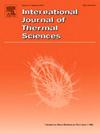Heat transfer and fluid dynamics of offset unsubmerged axial and tangential jets impinging on a confined heated rotating disk
IF 4.9
2区 工程技术
Q1 ENGINEERING, MECHANICAL
International Journal of Thermal Sciences
Pub Date : 2025-05-10
DOI:10.1016/j.ijthermalsci.2025.109984
引用次数: 0
Abstract
This study numerically investigates offset unsubmerged axial and tangential jets impingement on a confined heated rotating disk for electric motor cooling applications. The motor's rotor and stator are modeled as rotating and stationary solid regions, respectively. The multi-phase flow and heat transfer characteristics are analyzed over a range of rotational Reynolds numbers from 1 × 105 to 3.7 × 106 and jet Reynolds numbers ranging from 4.5 × 102 to 7.3 × 103 in a confined space. The jet nozzle diameter is 1.5 mm with the jet location fixed at an offset of 70 % of the disk radius. For axial and tangential jets, the ratio of jet impingement distance to nozzle diameter is held constant at 12 and 14.7, respectively. The Volume of Fluid method and a moving mesh rotation model are used to simulate the two-phase flow dynamics. The results show that axial jets achieve effective rotor cooling at a mid-range rotational Reynolds number of 2 × 106 and a jet Reynolds number of 7.3 × 103 but struggle to cool the stator due to limited oil distribution. Axial jet efficiency improves with higher jet Reynolds numbers; however, performance reduces at extreme rotational speeds, as oil contact with critical areas is reduced. Axial jets are thus most suitable for high rotor heat loads and oil flow rates, as their direct impingement enhances cooling effectiveness. In contrast, tangential jets rely heavily on an optimal velocity ratio between jet exit velocity and rotor speed to achieve efficient cooling. At rotational Reynolds number of 6.1 × 105, tangential jets deliver superior heat transfer and temperature uniformity with a lower jet Reynolds number of 3.7 × 103 and an ideal velocity ratio of 1, which promotes oil-air mixing and helical impingement. Tangential jets also exhibit up to 23 % lower drag losses at rotational Reynolds number of 6.1 × 105, and maintain lower pressure losses than axial jets, with an 15 % reduction at rotational Reynolds number of 3.7 × 106 due to better alignment with the rotating air. Overall, tangential jets are more efficient for lower flow rates and stator-focused cooling, while a mid-range rotational Reynolds number of 2 × 106 optimally balances oil distribution and cooling efficiency for both jet types.
偏置未淹没轴向和切向射流冲击受限加热旋转盘的传热和流体动力学
本研究以数值方法研究非浸没轴向及切向射流对电机冷却用受限加热旋转盘的冲击。电机的转子和定子分别被建模为旋转和静止的实体区域。在1 × 105 ~ 3.7 × 106旋转雷诺数和4.5 × 102 ~ 7.3 × 103射流雷诺数范围内,分析了密闭空间内的多相流动和换热特性。射流喷嘴直径为1.5 mm,射流位置固定在圆盘半径的70%偏移处。对于轴向射流和切向射流,射流撞击距离与喷嘴直径之比保持恒定,分别为12和14.7。采用流体体积法和运动网格旋转模型对两相流动力学进行了模拟。结果表明:轴向射流在旋转雷诺数为2 × 106和射流雷诺数为7.3 × 103时可以有效冷却转子,但由于油分布有限,对定子的冷却较为困难;射流雷诺数越高,轴向射流效率越高;然而,在极端转速下,由于油与关键区域的接触减少,性能会下降。轴向射流因此最适合于高转子热负荷和油流量,因为它们的直接撞击提高了冷却效率。相反,切向射流在很大程度上依赖于射流出口速度和转子速度之间的最佳速度比,以实现有效的冷却。旋转雷诺数为6.1 × 105时,切向射流具有较好的传热和温度均匀性,较低的射流雷诺数为3.7 × 103,理想的速度比为1,促进了油气混合和螺旋碰撞。在旋转雷诺数为6.1 × 105时,切向射流的阻力损失比轴向射流低23%,压力损失比轴向射流低,在旋转雷诺数为3.7 × 106时,由于与旋转空气更好的对齐,阻力损失比轴向射流低15%。总体而言,切向射流在低流速和定子聚焦冷却方面效率更高,而2 × 106的中程旋转雷诺数可以最佳地平衡两种射流的油分布和冷却效率。
本文章由计算机程序翻译,如有差异,请以英文原文为准。
求助全文
约1分钟内获得全文
求助全文
来源期刊

International Journal of Thermal Sciences
工程技术-工程:机械
CiteScore
8.10
自引率
11.10%
发文量
531
审稿时长
55 days
期刊介绍:
The International Journal of Thermal Sciences is a journal devoted to the publication of fundamental studies on the physics of transfer processes in general, with an emphasis on thermal aspects and also applied research on various processes, energy systems and the environment. Articles are published in English and French, and are subject to peer review.
The fundamental subjects considered within the scope of the journal are:
* Heat and relevant mass transfer at all scales (nano, micro and macro) and in all types of material (heterogeneous, composites, biological,...) and fluid flow
* Forced, natural or mixed convection in reactive or non-reactive media
* Single or multi–phase fluid flow with or without phase change
* Near–and far–field radiative heat transfer
* Combined modes of heat transfer in complex systems (for example, plasmas, biological, geological,...)
* Multiscale modelling
The applied research topics include:
* Heat exchangers, heat pipes, cooling processes
* Transport phenomena taking place in industrial processes (chemical, food and agricultural, metallurgical, space and aeronautical, automobile industries)
* Nano–and micro–technology for energy, space, biosystems and devices
* Heat transport analysis in advanced systems
* Impact of energy–related processes on environment, and emerging energy systems
The study of thermophysical properties of materials and fluids, thermal measurement techniques, inverse methods, and the developments of experimental methods are within the scope of the International Journal of Thermal Sciences which also covers the modelling, and numerical methods applied to thermal transfer.
 求助内容:
求助内容: 应助结果提醒方式:
应助结果提醒方式:


